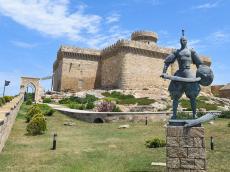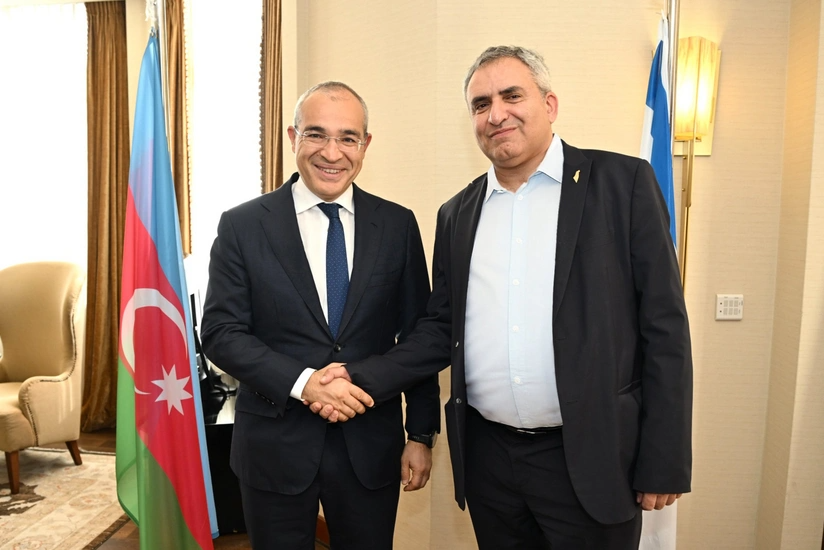|
|
TODAY.AZ / Society
Gala State Historical Reserve turns 30
20 December 2018 [15:59] - TODAY.AZ

By Azernews
By Laman Ismayilova
The 30th anniversary of Gala State Historical Ethnographic Reserve was solemnly marked.
Addressing the event, head of the reserve Malahat Farajova and director of the scientific and cultural center of Icherisheher State Historical and Architectural Reserve Javid Kazimov told about the history and implemented projects over the 30-year history of Gala Reserve, Trend Life reported.
The event was also attended by the elders of the village of Gala.
A gala concert was also held as part of the celebration.
The Gala State Historical Ethnographic Reserve is a complex of museums in Baku, Azerbaijan. The area of the museum extends to approximately 2 hectares.
It is located in Gala, 40km far from Baku and bears the name of this district. Gala-State Historical Ethnographic Reserve is devoted to the history of the Absheron Peninsula.
The reserve was established in the year of 2008 under the auspices of the Heydar Aliyev Foundation.
Three different types of museums: Museum of Archaeology and Ethnography (open-air), Castle Museum (partly open-air), and the Museum of Antiques are located on the territory of the reserve.
Of particular interest are cave paintings, ceramics, household items and decorations, weapons and coins, the conserved ruins of an ancient settlement, dating back to the period from the 3rd – 2nd millennium BC. e. to the Middle Ages, as well as ancient fortress dating back to the 10th-12th centuries.
There are more than 2,000 different archaeological and architectural monuments in the museum, including mounds, seats of ancient settlements, burial places dating back to thousands of years ago.
As a result of archaeological research, ancient caves, rock paintings, mounds, places of worship, traces of hearths, were discovered. The stones with images found on the territory of Agdash duzu and Dubendi are related to Bronze Age.
Hunting scenes, anthropomorphic and zoomorphic images are depicted on these stones.
Scenes of sacrifice, separate images of deer, goats, oxen, astral images - the sun, constellations - can also be found here. Ceramic dishes are dating back to the 12th-17th centuries. Ancient findings are presented in the open-air museum and a mosque next to Gesr tower.
A large number of coins belonging to the epochs of various khanates, as well as kauri sea shells were also discovered on the museum's territory.
Archaeological, historical and ethnographic materials indicate that Gala was one of the oldest shopping centers. Even in the 17th century, the European traveler Engelbert Kempfer wrote that salt, which is distinguished by its taste and whiteness, is mined in the village of Gala.
The eighteenth-century researcher, Johann Lerch, in his notes told about the journey to the village of Gala. In the 40s of the 19th century, the Russian traveler Berezin also mentioned in his notes the fortress in the village of Gala.
The territory of Gala Reserve was suitable for sowing in the Middle Ages, and the defense tower located here was restored by Nadir Shah.
In the Middle Ages, the village of Gala consisted of four so-called mehelle-quarters: Haji Ramazan, Chemberkend, Terekeme and Balaverdi. These quarters were divided into even smaller ones - courtyards. Each mehelle had its own separate area.
No any other village in the Absheron had so many mosques as Gala. There were six of them here.
The inhabitants of Gala were engaged in agriculture. They cultivated tobacco, wheat, saffron, corn, tomatoes, figs, and grapes.
There were special chimneys in their houses called "dubla".These houses usually consisted of two rooms. One room served as a living room and a bedroom, the other one was used for household purposes.
There were special shelves "leme" or "tahcha" in the living room.
The chest and bed were placed in a recess in the wall, called "jumahatan." In the middle of the room there was a hearth with coals, called "kursu".
The small table "kyatil" was placed there. It was covered with a large round blanket called the "kursu yorgan".
A family gathered around this table, covering themselves with "kursu yorgan".
There was also a machine for carpet weaving in the house. Carpet weaving in Baku villages was a widespread craft.
Construction of two-storey houses in Gala began in the late 19th- early 20thcentury. The first floor of this building was built in 1810. In the courtyard you can see a small pool carved out of stone. The kitchen here is separated from the main house.
In the kitchen there are "tahcha" shelves where the holy book Quran and "chirag" - a kerosene lamp are placed. There are also tandir and saj. On the second floor there is a terrace and two rooms. Rooms are motley decorated, handmade carpets were placed everywhere.
The museum’s exposition is enriched by more than 150 samovars of various sizes dating back to the 18th-19th centuries. Copper utensils and various jewelries made by local craftsmen are also represented here. There is also a place where camels, horses, mules, local breed of sheep are kept. Since ancient times, these animals were an important and necessary part of the life of a wealthy Gala resident.
Today it is a unique place where you can not only make a tour into the past, but also try to bake bread yourself in a tandir, weave a carpet, smear with clay in a pottery workshop or feed camels and horses.
/t_galaaaaa1.jpg)
/t_galaaaaa10.jpg)
/t_galaaaaa11.jpg)
/t_galaaaaa12.jpg)
/t_galaaaaa13.jpg)
/t_galaaaaa14.jpg)
/t_galaaaaa15.jpg)
/t_galaaaaa16.jpg)
/t_galaaaaa17.jpg)
/t_galaaaaa18.jpg)
/t_galaaaaa19.jpg)
/t_galaaaaa2.jpg)
/t_galaaaaa20.jpg)
/t_galaaaaa21.jpg)
/t_galaaaaa22.jpg)
/t_galaaaaa23.jpg)
/t_galaaaaa24.jpg)
/t_galaaaaa25.jpg)
/t_galaaaaa26.jpg)
/t_galaaaaa27.jpg)
/t_galaaaaa28.jpg)
/t_galaaaaa29.jpg)
/t_galaaaaa3.jpg)
/t_galaaaaa30.jpg)
/t_galaaaaa31.jpg)
/t_galaaaaa32.jpg)
/t_galaaaaa33.jpg)
/t_galaaaaa34.jpg)
/t_galaaaaa35.jpg)
/t_galaaaaa36.jpg)
/t_galaaaaa37.jpg)
/t_galaaaaa38.jpg)
/t_galaaaaa39.jpg)
/t_galaaaaa4.jpg)
/t_galaaaaa40.jpg)
/t_galaaaaa41.jpg)
/t_galaaaaa42.jpg)
/t_galaaaaa5.jpg)
/t_galaaaaa6.jpg)
/t_galaaaaa7.jpg)
/t_galaaaaa8.jpg)
/t_galaaaaa9.jpg)
URL: http://www.today.az/news/society/177282.html
 Print version
Print version
Connect with us. Get latest news and updates.
See Also
- 21 November 2025 [14:25]
Leyla Aliyeva, Arzu Aliyeva and Alena Aliyeva participate in environmental campaigns in Lankaran - 21 November 2025 [13:32]
Indonesia to host D-8 Forum in 2026–2027 - 21 November 2025 [13:29]
Azerbaijan highlights role of standards in green transition at COP30 - 21 November 2025 [12:58]
Azerbaijani, Chinese universities to establish joint medical working group - 21 November 2025 [11:37]
Armenian civil society delegation arrives in Baku for continued peace dialogue - 20 November 2025 [14:37]
National judo team joins training camp in Japan - 20 November 2025 [13:15]
National Art Museum to host lecture on Diego Rivera's art - 20 November 2025 [12:50]
Azerbaijan remains active in climate diplomacy after handing over COP Presidency to Brazil - 20 November 2025 [11:50]
Milli Majlis resumes review of key 2026 budget packages - 20 November 2025 [11:35]
US political affairs advisor honors fallen at Alley of Martyrs
Most Popular
 Azerbaijan, Israel hold fourth joint commission meeting in Jerusalem
Azerbaijan, Israel hold fourth joint commission meeting in Jerusalem
 Victim testimonies heard as trial of Ruben Vardanyan continues in Baku Military Court
Victim testimonies heard as trial of Ruben Vardanyan continues in Baku Military Court
 Turkiye expands its African sphere of influence with bold Libya shift
Turkiye expands its African sphere of influence with bold Libya shift
 IFC marks 30 years of support for Azerbaijan’s economic development
IFC marks 30 years of support for Azerbaijan’s economic development
 To whom is Khachaturian showing the Kremlin?
To whom is Khachaturian showing the Kremlin?
 Azerbaijan remains active in climate diplomacy after handing over COP Presidency to Brazil
Azerbaijan remains active in climate diplomacy after handing over COP Presidency to Brazil
 Justice Minister says terror-free Turkiye is essential for nation’s future
Justice Minister says terror-free Turkiye is essential for nation’s future
